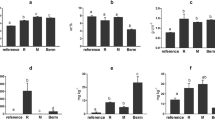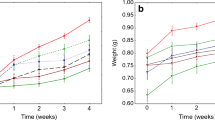Abstract
Purpose
Lead (Pb) is a highly studied contaminant with no known biological function that causes harmful adverse effects on ecological and human health. We tried to evaluate how protective the current soil regulatory levels are for Pb towards safeguarding the ecological health. In order to achieve this, our study evaluated the effect of soil texture and pH on the toxicity and availability of lead to earthworms in soils varying in soil properties.
Materials and methods
The earthworm Eisenia fetida was exposed to Pb in three soils with different physico-chemical characteristics. Pb solutions were homogenously mixed with soil to obtain concentrations ranging from 0 to 10,000 mg/kg Pb dry soil. Avoidance behaviour, weight loss and mortality were measured in this study to calculate the EC50 and LC50 values.
Results and discussion
Weight loss and mortality in earthworms due to Pb toxicity were in the following order: acidic > neutral > alkaline soil. The EC50 values resulting in 50% decrease in worm weight over control for Pb in acidic, neutral and alkaline soils were 460, 3606 and 5753 mg/kg soil, respectively. Thus, the acidic soil recorded an EC50 well below the soil guideline value for Pb. Whereas, the LC50 values resulting in 50% mortality in worms over control were 1161, 4648 and 7851 mg/kg, respectively, for acidic, neutral and alkaline soils. The Pb concentrations in earthworms ranged from 0.2 to 740 mg/kg wet weight. Soils with low clay content and acidic to neutral pH values demonstrated an increased Pb toxicity in earthworms compared to the soils with alkaline pH.
Conclusions
The worm weight loss is a more sensitive parameter than the mortality. This study emphasizes that the soil regulatory levels for Pb are not protective of worms in acidic soils. Therefore, care should be taken when using the current regulatory limits to assess and predict the safety of a contaminated site with acidic soils towards the ecological health.



Similar content being viewed by others
References
Akmal M, Xu JM (2009) Microbial biomass and bacterial community changes by Pb contamination in acidic soil. J Agr Biol Sci 1:30–37
Appel C, Ma LQ, Rhue RD, Reve W (2008) Sequential sorption of lead and cadmium in three tropical soils. Environ Pollut 155:132–140
Barton J, Conrad M, Harrison L, Nuby S (1978) Effects of calcium on the absorption and retention of lead. J Lab Clin Med 91:366–376
Blakemore L, Searle P, Daly B (1987) Methods for chemical analysis of soils. NZSoil Bureau Scientific Report 80:71–76
Bradham KD, Dayton EA, Basta NT, Schroder J, Payton M, Lanno RP (2006) Effect of soil properties on lead bioavailability and toxicity to earthworms. Environ Toxicol Chem 25:769–775
Cáceres T, Megharaj M, Venkateswarlu K, Sethunathan N, Naidu R (2010) Fenamiphos and related organophosphorus pesticides: environmental fate and toxicology. Rev Environ Contam Toxicol 205:117–162
Cao H-c, Luan Z-q, Wang J-d, Zhang X-l (2009) Potential ecological risk of cadmium, lead and arsenic in agricultural black soil in Jilin Province, China. Stoch Environ Res Risk Assess 23:57–64
Cartwright B, Merry R, Tiller K (1977) Heavy metal contamination of soils around a lead smelter at Port Pirie, South Australia. Aust J Soil Res 15:69–81
Chapman HD (1965) Cation exchange capacity. Methods of soil analysis, 2. American Society of Agronomy. Inc., Madison, pp. 891–900
Conder JM, Lanno RP (2000) Evaluation of surrogate measures of cadmium, lead, and zinc bioavailability to Eisenia fetida. Chemosphere 41:1659–1668
Davies NA, Hodson ME, Black S (2003) Is the OECD acute worm toxicity test environmentally relevant? The effect of mineral form on calculated lead toxicity. Environ Pollut 121:49–54
Edwards CA, Bohlen PJ (1996) Biology and ecology of earthworms, 3. Chapman & Hall, London
Fadrowski JJ, Navas-Acien A, Tellez-Plaza M, Guallar E, Weaver VM, Furth SL (2010) Blood lead level and kidney function in US adolescents: the third national health and nutrition examination survey. Arch Intern Med 170:75
Gee GW, Bauder JW, Klute A (1986) Particle-size analysis. Methods of soil analysis. Part 1. Physical and mineralogical methods. SSSA Book Series 5.1, 1986, pp 383–411
Harter RD (1983) Effect of soil pH on adsorption of lead, copper, zinc, and nickel. Soil Sci Soc Am J 47:47–51
Harter RD, Naidu R (2001) An assessment of environmental and solution parameter impact on trace-metal sorption by soils. Soil Sci Soc Am J 65:597–612
Ireland M (1979) Metal accumulation by the earthworms Lumbricus rubellus, Dendrobaena veneta and Eiseniella tetraedra living in heavy metal polluted sites. Environ Pollut 19:201–206
Jiang Y-m, Shi H, Li J-y, Shen C, Liu J-h, Yang H (2010) Environmental lead exposure among children in Chengdu, China: blood lead levels and major sources. B Environ Contam Tox 84:1–4
Khan NZ, Khan AH (1999) Lead poisoning and psychomotor delay in Bangladeshi children. Lancet 353:754
Kidd PS, Domínguez-Rodríguez MJ, Díez J, Monterroso C (2007) Bioavailability and plant accumulation of heavy metals and phosphorus in agricultural soils amended by long-term application of sewage sludge. Chemosphere 66:1458–1467
Lanno R, Wells J, Conder J, Bradham K, Basta N (2004) The bioavailability of chemicals in soil for earthworms. Ecotoxicol Environ Saf 57:39–47
Lokke H, Gestel CAM (1998) Handbook of soil invertebrate toxicity tests, ecological & environmental toxicology series. Wiley, Chichester, pp. 281–285
Manceau A, Charlet L, Boisset M, Didier B, Spadini L (1992) Sorption and speciation of heavy metals on hydrous Fe and Mn oxides. From microscopic to macroscopic. Appl Clay Sci 7:201–223
McBride M, Sauve S, Hendershot W (1997) Solubility control of Cu, Zn, Cd and Pb in contaminated soils. Eur J Soil Sci 48:337–346
Morgan J, Morgan A (1988) Earthworms as biological monitors of cadmium, copper, lead and zinc in metalliferous soils. Environ Pollut 54:123–138
Morgan J, Morgan A (1989) Zinc sequestration by earthworm (Annelida: Oligochaeta) chloragocytes. Histochemistry 90:405–411
Naidu R, Harter R (1998) Effect of different organic ligands on cadmium sorption by and extractability from soils. Soil Sci Soc Am J 62:644–650
Naidu R, Bolan NS, Kookana RS, Tiller K (1994) Ionic-strength and pH effects on the sorption of cadmium and the surface charge of soils. Eur J Soil Sci 45:419–429
Neuhauser EF, Loehr RC, Milligan DL, Malecki MR (1985) Toxicity of metals to the earthworm Eisenia fetida. Biol Fertil Soils 1:149–152
Park JH, Bolan NS, Chung JW, Naidu R, Megharaj M (2011) Environmental monitoring of the role of phosphate compounds in enhancing immobilization and reducing bioavailability of lead in contaminated soils. J Environ Monit 13:2234–2242
Peijnenburg W, Jager T (2003) Monitoring approaches to assess bioaccessibility and bioavailability of metals: matrix issues. Ecotoxicol Environ Saf 56:63–77
Reid BJ, Watson R (2005) Lead tolerance in Aporrectodea rosea earthworms from a clay pigeon shooting site. Soil Biol Biochem 37:609–612
Saper RB, Phillips RS, Sehgal A, Khouri N, Davis RB, Paquin J, Thuppil V, Kales SN (2008) Lead, mercury, and arsenic in US- and Indian-manufactured Ayurvedic medicines sold via the Internet. J Am Med Assoc 300:915–923
Sauve S, McBride M, Hendershot W (1998) Soil solution speciation of lead (II): effects of organic matter and pH. Soil Sci Soc Am J 62:618–621
Smith E, Kempson IM, Juhasz AL, Weber J, Rofe A, Gancarz D, Naidu R, McLaren RG, Gräfe M (2011) In vivo–in vitro and XANES spectroscopy assessments of lead bioavailability in contaminated periurban soils. Environ Sci Technol 45:6145–6152
US EPA (2000) Risk-based concentration table. United States Environmental Protection Agency, Philadelphia PA, pp. 1–45
Walkley A, Black IA (1934) An examination of the Degtjareff method for determining soil organic matter, and a proposed modification of the chromic acid titration method. Soil Sci 37:29–38
Wijayawardena MA, Megharaj M, Naidu R (2012) Bioavailability and toxicity of arsenic to earthworms in three soils. In: Ng JC, Noller BN, Naidu R, Bundschuh J, Bhattacharya P (eds) Understanding the geological and medical interface of arsenic—As 2012. Proceedings of the 4th International Congress on Arsenic in the Environment, 22–27 July 2012, Cairns, Australia. CRC Press, p 251
Wijayawardena MAA, Naidu R, Megharaj M, Lamb D, Thavamani P, Kuchel T (2014) Influence of ageing on lead bioavailability in soils: a swine study. Environ Sci Pollut Res 22:8979–8988
Woolf AD, Goldman R, Bellinger DC (2007) Update on the clinical management of childhood lead poisoning. Pediatr Clin N Am 54:271–294
Yang J-K, Barnett MO, Jardine PM, Brooks SC (2003) Factors controlling the bioaccessibility of arsenic(V) and lead(II) in soil. Soil Sediment Contam 12:165–179
Acknowledgements
We would like to sincerely thank the Centre for Environmental Risk Assessment and Remediation, University of South Australia, and Global Centre for Environmental Remediation, University of Newcastle, for the laboratory facilities and the Cooperative Research Centre for Contamination Assessment and Remediation of the Environment (CRCCARE) postgraduate scholarship for funding the research.
Author information
Authors and Affiliations
Corresponding author
Additional information
Responsible editor: Kirk T. Semple
Rights and permissions
About this article
Cite this article
Wijayawardena, M.A.A., Megharaj, M. & Naidu, R. Bioaccumulation and toxicity of lead, influenced by edaphic factors: using earthworms to study the effect of Pb on ecological health. J Soils Sediments 17, 1064–1072 (2017). https://doi.org/10.1007/s11368-016-1605-0
Received:
Accepted:
Published:
Issue Date:
DOI: https://doi.org/10.1007/s11368-016-1605-0




